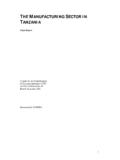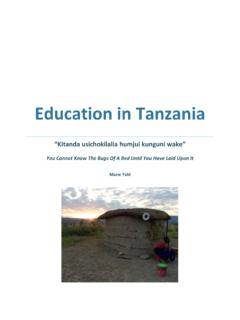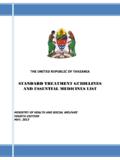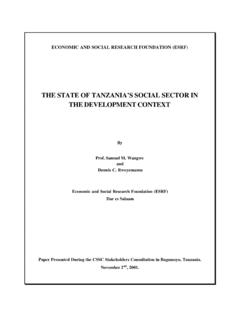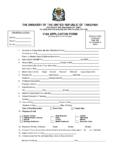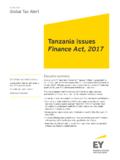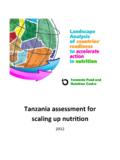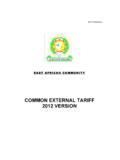Transcription of Mobile Money in Tanzania - InterMedia
1 Mobile Money in Tanzania Use, Barriers and Opportunities The Financial Inclusion Tracker Surveys Project, February 2013. Table of Contents Executive Summary .. 3. Glossary.. 5. Methodology..6. Tanzania Country Profile.. 7. Mobile Money Adoption .. 9. Mobile Money adoption at the household level .. 9. Mobile Money adoption at the individual level.. 10. Market share in the Tanzanian Mobile Money services sector .. 10. Motivators for and Barriers to the Adoption of Mobile Money Services.. 13. The dynamics of adoption and use.. 13. Sources of information about Mobile Money .. 14. Mobile Money adoption motivators.
2 14. Barriers to Mobile Money adoption .. 14. Mobile Money use for personal savings.. 17. Mobile Money use for business.. 17. Lessons from registered Mobile Money users' recent experiences with Mobile Money agents.. 18. Households' financial routines and the role of Mobile Money .. 19. Remittances: Sending and receiving patterns .. 19. Non-remittance payments: Sending and receiving patterns.. 22. Mechanisms for household savings.. 23. Insurance and loans.. 24. Households' responses to economic shocks.. 27. Negative economic shocks.. 27. Positive economic shocks.. 28. Conclusions.. 29. Endnotes.
3 30. 2 Mobile Money in Tanzania : Use, Barriers and Opportunities EXECUTIVE SUMMARY. In 2011, the Bill & Melinda Gates Foundation's (BMGF) Financial Services for the Poor (FSP) program commissioned InterMedia to design and implement a project to track the uptake, use and market potential of Mobile Money (m- Money ) services in Pakistan, Uganda and Tanzania . The findings from the Financial Inclusion Tracker Surveys Project (FITS), which includes annual panel- based surveys conducted on a national scale, are intended to support the m- Money activities of the BMGF, development organizations, Mobile operators, regulators and others who play active roles in m- Money ecosystems.
4 The surveys also are designed to facilitate analyses of m- Money 's relationship to household financial behaviors, particularly a household's ability to manage economic shocks. This summary presents the key findings from the first annual FITS survey of 2,980 households in Tanzania conducted in April and May 2012. The first annual FITS Uganda survey report, published October 2012, is available on AudienceScapes. Tanzania and Mobile Money Based on the current rate of access to Mobile phones, the Tanzanian market shows potential for further m- Money adoption. Sixty-three percent of surveyed households have access to a Mobile phone.
5 Fifty-six percent of households own at least one active SIM card which is required for opening an m- Money account. Even among rural, unbanked and poor households (those living on less than $2 a day), about one-half of households have access to a Mobile phone and own a SIM card. Based on users' perspectives, the leading challenge to m- Money uptake is the inconsistent service quality offered by m- Money agents. The large majority of registered users reported they had encountered problems with agents. In particular, they cited agents' absenteeism and insufficient e-float or cash to help with a transaction.
6 Another impediment to m- Money uptake suggested by the survey findings is an insufficient understanding of m- Money applications by potential and current users. Key Findings Thirty-five percent of households in Tanzania have at least one m- Money user; 33 percent of households have at least one registered m- Money user. Vodacom M-Pesa is the leading provider of m- Money services (representing 53 percent of the m- Money market) and has broad national coverage. Tigo Pesa (18 percent of the m- Money market). and Airtel Money (13 percent of the m- Money market) are the second and third ranked providers. While m- Money services have been available since 2008, most registered users said they didn't sign up for an m- Money account until 2010 or 2011.
7 The number of early adopters of m- Money services (those who started using m- Money before 2010) is small regardless of the specific provider: 16 percent of current registered users of Airtel Money and 9 percent of registered users of Vodacom M-Pesa. Tigo Pesa was not in operation until late 2010. InterMedia 3. Awareness of m- Money services appears to be high. When asked about the top three reasons for not using m- Money , only 13 percent of nonusers said they were unaware of the services. m- Money Three-quarters of registered users learned about m- Money m- Money m- Money from media sources (mainly from TV or radio), and one in five learned from friends.
8 Friends were the most important drivers of m- Money adoption. M- Money services are most frequently used to send or receive remittances as part of regular financial support to or from family members living in different households. Twenty-one percent of Vodacom M-Pesa users and 12 percent of users of both Airtel Money and Tigo Pesa use their accounts for business transactions primarily to buy inventory and receive payments for goods and services. M- Money is the second most popular savings instrument after a hiding place. Half of households with m- Money users use an m- Money account to save Money ; the majority saves either for a specific future purchase or for an emergency.
9 The use of m- Money for delivering non-remittance payments is not common and the market for non-remittance payments is small. Only 14 percent of all households made or received a non-remittance payment in the past six months using any type of cash delivery, including m- Money . The most common types of payments included school fees, government fees and taxes, utility bills, and salaries. Households with m- Money users engage in a wider variety of financial activities and are more likely to save Money and buy insurance than households that do not use m- Money services. When responding to a negative economic shock ( , illness of a household member), most households first deplete their cash savings.
10 Households that use m- Money appear to receive remittances (from family and friends) in response to negative economic shocks at a slightly higher rate than households with no m- Money users. Subsequent FITS survey reports will monitor market growth and measure whether challenges to new or greater adoption have been overcome, particularly among the unbanked and those living at the bottom of the pyramid. FITS data, reports and related analyses are disseminated to stakeholders in the financial access community, both in the countries studied and globally, to help inform policies and practices in the field of financial inclusion.


